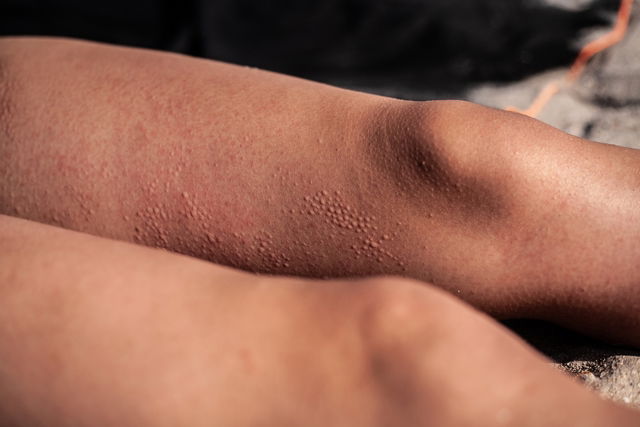A heat rash occurs when the body temperature becomes elevated, leading to the appearance of small blisters or red rashes on the skin. These can be itchy and cause swelling in the affected areas.
Although the exact cause of a heat rash is not well known, it may be related to an allergic reaction to sweat, or to a response from the nervous system caused by stress and anxiety. It can occur on vey hot or humid days or after an intense workout, for example.
A heat rash usually do not require medications, and can be relieve with home remedies like taking a cold bath or applying soothing creams. Nonetheless, it is important to see a dermatologist if you experience frequent or severe sweat blisters.

Main symptoms
The main symptoms of a heat rash include:
- Small red blisters that appear in areas exposed to the sun or in areas prone to sweating
- Itchiness in the affected areas
- Crusting of the blisters from itching
- The emergence of a red rash on the skin
- Swelling in the affected areas
A heat rash can occur at any age, although it is most often observed in babies, older adults, and bedridden patients. Sweat blisters are typically seen in the neck and armpits.
In addition to these symptoms, patients who stay in the sun or hot environments for prolonged periods of time may also experience nausea, diarrhea, difficulty breathing, vomiting and fatigue. These are usually symptoms of overheating and should be assessed by a doctor.
Confirming a diagnosis
A heat rash diagnosis is confirmed by a dermatologist or family doctor, who will assess your symptoms, health history and other risk factors, such as prolonged exposure to the sun or regular physical activity.
Generally, no additional tests are needed, but the doctor may recommend an exercise test to assess the onset of symptoms.
In addition, in cases where there is doubt about the diagnosis, the doctor may order an allergy test to rule out allergies triggered by other substances.
Possible causes
A heat rash is caused by an immune system response against sweat antigens. It is usually related to an increase in body temperature, triggering cholinergic urticaria.
This type of allergy is more common in people with atopic dermatitis, since sweating can exacerbate the symptoms of atopic dermatitis.
Treatment options
Treatment of sweat blisters involves hydrating the skin well with soothing lotions that contain aloe vera or calamine. You should also bathe in cold water, drink plenty of water, use light clothing, and avoid excessive sweating. Affected areas or the skin should be kept uncovered.
These measures may not be sufficient in managing severe cases of heat rashes, and therefore, should be assessed by a doctor. The doctor may opt to prescribe lotions, creams or ointments with corticosteroids, like hydrocortisone or betamethasone. Topical medications with corticosteroids should be used in small quantities and applied in a thin layer for a specified amount of time to prevent further skin damage.
For babies, you should pat affected areas, like the neck, with a dry, clean cloth. You can also apply baby powder to prevent friction and irritation. Babies with very irritated skin can be bathed in water several times throughout the day, being sure to avoid any shampoos or soaps.
